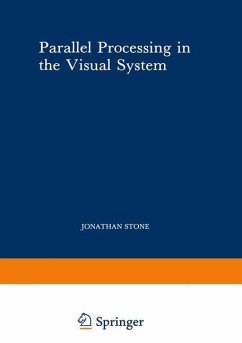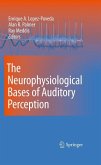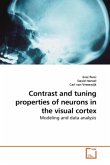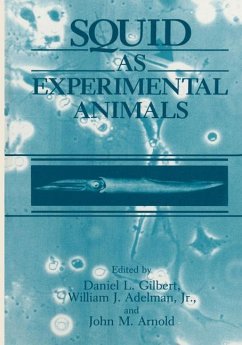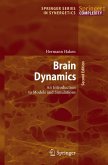Jonathan Stone
Parallel Processing in the Visual System
The Classification of Retinal Ganglion Cells and its Impact on the Neurobiology of Vision
Jonathan Stone
Parallel Processing in the Visual System
The Classification of Retinal Ganglion Cells and its Impact on the Neurobiology of Vision
- Broschiertes Buch
- Merkliste
- Auf die Merkliste
- Bewerten Bewerten
- Teilen
- Produkt teilen
- Produkterinnerung
- Produkterinnerung
In the mid-sixties, John Robson and Christina Enroth-Cugell, without realizing what they were doing, set off a virtual revolution in the study of the visual system. They were trying to apply the methods of linear systems analysis (which were already being used to describe the optics of the eye and the psychophysical performance of the human visual system) to the properties of retinal ganglion cells in the cat. Their idea was to stimulate the retina with patterns of stripes and to look at the way that the signals from the center and the antagonistic surround of the respective field of each…mehr
Andere Kunden interessierten sich auch für
![The Neurophysiological Bases of Auditory Perception The Neurophysiological Bases of Auditory Perception]() The Neurophysiological Bases of Auditory Perception150,99 €
The Neurophysiological Bases of Auditory Perception150,99 €![Contrast and tuning properties of neurons in the visual cortex Contrast and tuning properties of neurons in the visual cortex]() Erez PersiContrast and tuning properties of neurons in the visual cortex38,99 €
Erez PersiContrast and tuning properties of neurons in the visual cortex38,99 €![Squid as Experimental Animals Squid as Experimental Animals]() Squid as Experimental Animals150,99 €
Squid as Experimental Animals150,99 €![Chloride Channels and Carriers in Nerve, Muscle, and Glial Cells Chloride Channels and Carriers in Nerve, Muscle, and Glial Cells]() Chloride Channels and Carriers in Nerve, Muscle, and Glial Cells149,99 €
Chloride Channels and Carriers in Nerve, Muscle, and Glial Cells149,99 €![Ion Channels Ion Channels]() Ion Channels115,99 €
Ion Channels115,99 €![Brain Dynamics Brain Dynamics]() Hermann HakenBrain Dynamics38,99 €
Hermann HakenBrain Dynamics38,99 €![Ion Channels Ion Channels]() Ion Channels115,99 €
Ion Channels115,99 €-
-
-
In the mid-sixties, John Robson and Christina Enroth-Cugell, without realizing what they were doing, set off a virtual revolution in the study of the visual system. They were trying to apply the methods of linear systems analysis (which were already being used to describe the optics of the eye and the psychophysical performance of the human visual system) to the properties of retinal ganglion cells in the cat. Their idea was to stimulate the retina with patterns of stripes and to look at the way that the signals from the center and the antagonistic surround of the respective field of each ganglion cell (first described by Stephen Kuffier) interact to generate the cell's responses. Many of the ganglion cells behaved themselves very nicely and John and Christina got into the habit (they now say) of calling them I (interesting) cells. However. to their annoyance, the majority of neurons they recorded had nasty, nonlinear properties that couldn't be predicted on the basis of simple summ4tion of light within the center and the surround. These uncoop erative ganglion cells, which Enroth-Cugell and Robson at first called D (dull) cells, produced transient bursts of impulses every time the distribution of light falling on the receptive field was changed, even if the total light flux was unaltered.
Produktdetails
- Produktdetails
- Perspectives in Vision Research
- Verlag: Springer US / Springer, Berlin
- Softcover reprint of the original 1st ed. 1983
- Seitenzahl: 456
- Erscheinungstermin: 17. März 2012
- Englisch
- Abmessung: 254mm x 178mm x 25mm
- Gewicht: 851g
- ISBN-13: 9781468444353
- ISBN-10: 1468444352
- Artikelnr.: 39492501
- Herstellerkennzeichnung Die Herstellerinformationen sind derzeit nicht verfügbar.
- Perspectives in Vision Research
- Verlag: Springer US / Springer, Berlin
- Softcover reprint of the original 1st ed. 1983
- Seitenzahl: 456
- Erscheinungstermin: 17. März 2012
- Englisch
- Abmessung: 254mm x 178mm x 25mm
- Gewicht: 851g
- ISBN-13: 9781468444353
- ISBN-10: 1468444352
- Artikelnr.: 39492501
- Herstellerkennzeichnung Die Herstellerinformationen sind derzeit nicht verfügbar.
Jonathan Stone ist Absolvent der Yale-Universität in New Haven, wo er Stipendiat im Fachbereich für Fiktionales Schreiben war und zweimal den John-Hubbard-Curtis-Preis als bester Autor gewann. Neben seiner literarischen Tätigkeit arbeitet er in der Werbebranche und lebt mit seiner Frau und zwei Kindern in Connecticut.
I. The Classification of Retinal Ganglion Cells.
1. From the Beginning: Ganglion Cell Classification to 1966.
1.1. Conduction Velocity Groupings in the Optic Nerve.
1.2. Receptive Field Studies of Retinal Ganglion Cells.
1.2.1. Parametric Analyses of Receptive Fields.
1.2.2. Feature Extraction Analyses of Receptive Fields.
1.3. Morphological Classifications of Ganglion Cells.
1.4. Function or Phylogeny as a Basis for Ganglion Cell Classifications?.
2. The Y/X/W Classification of Cat Retinal Ganglion Cells.
2.1. The Development of the Y/X/W Classification.
2.1.1. Description of the X/Y Difference.
2.1.2. Conduction Velocity Correlates of X and Y Cells.
2.1.3. The W
Cell Grouping.
2.1.4. Morphological Classes of Cat Ganglion Cells.
2.2. The Y/X/W Classification: Categories and Taxa.
2.2.1. Evidence for Choice of Categories.
2.2.2. Evidence for Choice of Taxa.
2.3. The Interpretation of Variation: A Central Problem in Cell Classification.
2.3.1. "Single" and "Multiple" Interpretations of Variation.
2.3.2. Sources of Variation in the Properties of Ganglion Cells.
2.3.3. A Multiple Interpretation of Variation in the Properties of Ganglion Cells.
2.4. A Two
Group (XY/W) Classification of Cat Retinal Ganglion Cells.
2.5. Two Notes on the Classification of Nerve Cells.
2.5.1. Incommensurable Classifications.
2.5.2. Mixed Classifications: The Best of Both Approaches?.
3. Ganglion Cell Classification in Other Species.
3.1. In the Monkey.
3.1.1. Conduction Velocity Groupings.
3.1.2. Physiological Classifications: Parametric and Feature Extraction.
3.1.3. The W
like System of Ganglion Cells.
3.1.4. Morphological Classifications.
3.1.5. Summary.
3.2. In the Rat.
3.2.1. Conduction Velocity Groupings.
3.2.2. Receptive Field Correlates: Is There an X
like Group?.
3.2.3. Morphological Classifications.
3.2.4. Summary.
3.3. In the Rabbit.
3.3.1. Conduction Velocity Groupings.
3.3.2. The Feature Extraction Classification of Rabbit Ganglion Cells.
3.3.3. More Parametric Analyses.
3.3.4. Summary.
3.4. In Other Mammals: Tree Shrew, Goat, and Ground Squirrel.
3.4.1. Tree Shrew.
3.4.2. Goat and Ground Squirrel.
3.5. In Nonmammals: Frog, Toad, Pigeon, Eel, and Mudpuppy.
3.5.1. Frog and Toad.
3.5.2. Pigeon.
3.5.3. Eel and Mudpuppy.
II. On the Methodology of Classification.
4. Toward Certainty, Objectivity, or Testability? Two Notes on Alternative Methodologies of Classification.
4.1. Alternative Methodologies of Classification: Their Basis in the Concerns of Classifiers.
4.1.1. Nominalism and Realism.
4.1.2. Different Realist Approaches: Toward Certainty, Objectivity, or Testability.
4.1.3. Summary.
4.2. Three Stages in the Taxonomy of Animals.
4.2.1. Aristotle's Taxonomy: Metaphysical Essentialism.
4.2.2. Physical Typology.
4.2.3. The Influence of the Theory of Evolution.
5. Epistemological Background: Inductivism, Essentialism, Instrumentalism, Falsificationism, and Paradigms.
5.1. Inductivism.
5.2. Essentialism (Typology).
5.3. Instrumentalism.
5.4. Falsificationism.
5.5. Paradigms and Revolutions.
5.6. A Falsificationist Approach to the Classification of Neurons.
III. The Impact of Ganglion Cell Classification.
6. On the Understanding of Visual Processing in the Diencephalon.
6.1. The LGN of the Cat.
6.1.1. Evidence of Parallel Processing in the LGN.
6.1.2. The W
Cell Relay in the dLGN.
6.1.3. The Medial Interlaminar Nucleus.
6.1.4. The vLGN.
6.1.5. The Lamination of the dLGN.
6.1.6. Morphology of Relay Cells.
6.1.7. Cortical Projections of Y
, X
, and W
Class Relay Cells.
6.1.8. Corticogeniculate Projections.
6.2. The LGN of Primates.
6.2.1. X/Y Analysis of Parvo
and Magnocellular Laminae.
6.2.2. Other Components of the LGN.
6.2.3. Corticofugal Projections.
6.2.4. Summary.
6.3. Other Species.
6.3.1. The LGN of the Rat.
6.3.2. The LGN of the Tree Shrew.
6.3.3. The LGN of the Mink.
6.3.4. Summary.
6.4. Qualifications to the Parallel Processing Model of the LGN.
6.5. The Hypothalamus.
6.6. The Pulvinar: Evidence for an Extrageniculate W
Cell Relay.
7. On the Understanding of the Visual Centers of the Midbrain.
7.1. The Midbrain/Forebrain Division of the Visual Pathways: By Branching or Grouping of Ganglion Cells?.
7.2. The Superior Colliculus of the Cat.
7.2.1. Early Evidence: Conduction Velocity Analysis of the Retinocollicular Projections.
7.2.2. Receptive Field Correlates: Hoffmann's Three
Channel Model of the Retinocollicular Projection.
7.2.3. The Influence of the Visual Cortex and of Visual Deprivation on the Superior Colliculus.
7.2.4. Qualifications and Limitations.
7.3. The Superior Colliculus of the Monkey.
7.4. The Superior Colliculus of Other Species.
7.4.1. The Rat.
7.4.2. The Rabbit.
7.4.3. The Hamster.
7.4.4. The Opossum.
7.4.5. Summary.
7.5. Other Midbrain Centers.
7.5.1. The Pretectal Nuclei and the Nucleus of the Optic Tract.
7.5.2. Nuclei of the Accessory Optic Tract and Nucleus Raphe Dorsalis.
8. On the Understanding of Visual Cortex.
8.1. Cat Visual Cortex: Processing of Geniculate Input.
8.1.1. Parallel Pathways to Different Cortical Areas.
8.1.2. Parallel Organization of Area 17: Correlations between Afferent Input and Receptive Field Properties.
8.1.3. Parallel Organization of Area 17: Analyses of Its Lamination.
8.1.4. Corticofugal Projections of Areas 17, 18, and 19.
8.2. Primate Visual Cortex: Processing of Geniculate Input.
8.2.1. Parallel Organization of Area 17.
8.2.2. Organization of the Prestriate Cortex.
8.3. Cortical Afferents from Extrageniculate Sources.
8.3.1. Sources of Extrageniculate Afferents in the Cat.
8.3.2. Sources of Extrageniculate Afferents in the Monkey.
8.3.3. Functional Significance of the "Second" Visual Pathway.
8.4. Models of Neuronal Processing within the Striate Cortex: An Argument against Serial Processing.
8.4.1. The Simple/Complex Model of Serial Intracortical Processing.
8.4.2. Synaptic Latencies: A Second Line of Evidence for Serial Processing?.
8.4.3. Summary.
8.5. Future Work: The Importance of the Classification and Terminology Used for Cortical Cells.
9. On the Understanding of Retinal Topography: A "Two
Axis" Model of Mammalian Retina.
9.1. The Problem: The Variability of Retinal Topography.
9.2. A Two
Axis Model of the Topography of Mammalian Retina.
9.3. The Vertical Axis: The Nasotemporal Division of Retina.
9.3.1. Historical Note: The Nasotemporal Division of Human Retina.
9.3.2. The Nasotemporal Division of the Retina in the Monkey.
9.3.3. The Nasotemporal Division of the Retina in the Common Cat.
9.3.4. The Nasotemporal Division of the Retina in the Siamese Cat.
9.3.5. The Nasotemporal Division of the Retina in Marsupials, the Rabbit, Rodents, and the Fox.
9.3.6. Summary.
9.4. The Horizontal Axis: The Visual Streak.
9.4.1. The Visual Streak of the Rabbit Retina.
9.4.2. The Visual Streak of the Cat Retina.
9.4.3. Evidence of a Visual Streak in the Monkey and Other Primates.
9.4.4. The Opossum: An Exception?.
9.4.5. Summary.
9.5. The Fovea or Area Centralis: A Specialization at the Junction of the Two Axes.
9.5.1. The Fovea Centralis of the Monkey and Other Primates.
9.5.2. The Area Centralis of the Cat.
9.5.3. Evidence of an Area Centralis in the Rabbit Retina.
9.5.4. Summary.
9.6. Two Regional Specializations Related to the Axis of Nasotemporal Division.
9.6.1. Nasal
Temporal Gradients in the Properties of Ganglion Cells.
9.6.2. A Vertical Streak?.
9.7. How Generally Can the Model be Applied?.
9.7.1. The Generality of the Area Centralis.
9.7.2. The Generality of the Visual Streak.
9.7.3. The Generality of the Nasotemporal Division of the Retina.
9.7.4. The Siamese Cat: A Case to Prove Two Points.
9.8. Functional Significance of Regional Specializations.
9.8.1. The Nasotemporal Division of the Retina.
9.8.2. The Fovea or Area Centralis and the "Vertical Streak".
9.8.3. Nasal
Temporal Differences in Ganglion Cell Properties.
9.8.4. The Visual Streak.
9.8.5. Retinal Topography: The Influence of Visual Environment and Phylogenetic Heritage.
9.8.6. Significance of the Two
Axis Model: A Ground Plan for the Topography of Mammalian Retina.
10. On the Understanding of the Visual Pathways' Dependence on the Visual Environment.
10.1. Introduction: Three Starting Points.
10.1.1. Amblyopia: The Clinical Starting Point.
10.1.2. The Philosophical Starting Point: Rationalism and Empiricism.
10.1.3. Animal Models of Amblyopia: The Neurobiologists' Starting Point.
10.1.4. Summary.
10.2. Effects of Visual Deprivation on the LGN of the Cat.
10.2.1. The "Loss" of Y Cells from the LGN of Visually Deprived Cats: Its Nature, Morphological Correlates, and Cause.
10.2.2. An Abnormality of Geniculate X Cells in Visually Deprived Cats: A "Direct" Effect of Deprivation.
10.2.3. Other Evidence of a "Direct" Mechanism in Visual Deprivation.
10.2.4. The Effect of Visual Deprivation on W
Class Relay Cells.
10.2.5. The Effect of Immobilizing the Eye.
10.3. Effects of Visual Deprivation on Cat Retinal Ganglion Cells.
10.4. Effects of Visual Deprivation on the SC of the Cat.
10.5. Effects of Visual Deprivation on the Visual Cortex of the Cat.
10.5.1. Which Stimulus Selectivities Can Develop without Visual Experience?.
10.5.2. Determinants of Ocular Dominance.
10.5.3. Eccentricity
Related Differences in the Modifiability of Orientation Stripes.
10.6. Effects of Visual Deprivation in Other Species.
10.6.1. In the Monkey.
10.6.2. In the Tree Shrew.
10.7. Conclusion: W, X, and Y Components of the Neural Basis of Amblyopia.
11. On the Understanding of Visual Psychophysics and Behavior.
11.1. Introduction.
11.2. The Focal/Ambient Division of Visual Function and Its Neural Basis.
11.2.1. The Focal/Ambient Division of Visual Function.
11.2.2. Evidence in Humans.
11.2.3. Evidence in Monkeys.
11.2.4. Evidence in Cats.
11.2.5. Summary.
11.3. Evidence of Distinct X and Y Contributions to Focal Vision.
11.3.1. The Dual
Mechanism Hypothesis of the Perception of Form and Motion.
11.3.2. Qualifications.
11.3.3. The Oblique Effect: A Psychophysical Correlate of X
Cell Function.
11.4. The Neural Representation of Visual Perception: A Comment.
12. Extensions and Limits of the Parallel Processing Analysis.
12.1 Parallel Processing in the Somatosensory Pathways.
12.1.1. Classification of Somatosensory Afferents.
12.1.2. Channeling of Submodalities through Spinal Cord and Brain Stem.
12.1.3. The Parallel Organization of Somatosensory Thalamus.
12.1.4. The Parallel Organization of Somatosensory Cortex.
12.1.5. Summary.
12.2. Notes on Other Sensory Pathways.
12.2.1. The Auditory Pathways.
12.2.2. The Chemical Senses.
12.3. Ideas and Their Limits.
12.4. "Parametric Systematics": An Approach to the Understanding of Sensory Pathways.
12.4.1. Two Terms: Reductionist and "Holistic".
12.4.2. The Technical Limits of Ideas.
12.4.3. A "Parametric Systematics" for Sensory Biology.
References.
1. From the Beginning: Ganglion Cell Classification to 1966.
1.1. Conduction Velocity Groupings in the Optic Nerve.
1.2. Receptive Field Studies of Retinal Ganglion Cells.
1.2.1. Parametric Analyses of Receptive Fields.
1.2.2. Feature Extraction Analyses of Receptive Fields.
1.3. Morphological Classifications of Ganglion Cells.
1.4. Function or Phylogeny as a Basis for Ganglion Cell Classifications?.
2. The Y/X/W Classification of Cat Retinal Ganglion Cells.
2.1. The Development of the Y/X/W Classification.
2.1.1. Description of the X/Y Difference.
2.1.2. Conduction Velocity Correlates of X and Y Cells.
2.1.3. The W
Cell Grouping.
2.1.4. Morphological Classes of Cat Ganglion Cells.
2.2. The Y/X/W Classification: Categories and Taxa.
2.2.1. Evidence for Choice of Categories.
2.2.2. Evidence for Choice of Taxa.
2.3. The Interpretation of Variation: A Central Problem in Cell Classification.
2.3.1. "Single" and "Multiple" Interpretations of Variation.
2.3.2. Sources of Variation in the Properties of Ganglion Cells.
2.3.3. A Multiple Interpretation of Variation in the Properties of Ganglion Cells.
2.4. A Two
Group (XY/W) Classification of Cat Retinal Ganglion Cells.
2.5. Two Notes on the Classification of Nerve Cells.
2.5.1. Incommensurable Classifications.
2.5.2. Mixed Classifications: The Best of Both Approaches?.
3. Ganglion Cell Classification in Other Species.
3.1. In the Monkey.
3.1.1. Conduction Velocity Groupings.
3.1.2. Physiological Classifications: Parametric and Feature Extraction.
3.1.3. The W
like System of Ganglion Cells.
3.1.4. Morphological Classifications.
3.1.5. Summary.
3.2. In the Rat.
3.2.1. Conduction Velocity Groupings.
3.2.2. Receptive Field Correlates: Is There an X
like Group?.
3.2.3. Morphological Classifications.
3.2.4. Summary.
3.3. In the Rabbit.
3.3.1. Conduction Velocity Groupings.
3.3.2. The Feature Extraction Classification of Rabbit Ganglion Cells.
3.3.3. More Parametric Analyses.
3.3.4. Summary.
3.4. In Other Mammals: Tree Shrew, Goat, and Ground Squirrel.
3.4.1. Tree Shrew.
3.4.2. Goat and Ground Squirrel.
3.5. In Nonmammals: Frog, Toad, Pigeon, Eel, and Mudpuppy.
3.5.1. Frog and Toad.
3.5.2. Pigeon.
3.5.3. Eel and Mudpuppy.
II. On the Methodology of Classification.
4. Toward Certainty, Objectivity, or Testability? Two Notes on Alternative Methodologies of Classification.
4.1. Alternative Methodologies of Classification: Their Basis in the Concerns of Classifiers.
4.1.1. Nominalism and Realism.
4.1.2. Different Realist Approaches: Toward Certainty, Objectivity, or Testability.
4.1.3. Summary.
4.2. Three Stages in the Taxonomy of Animals.
4.2.1. Aristotle's Taxonomy: Metaphysical Essentialism.
4.2.2. Physical Typology.
4.2.3. The Influence of the Theory of Evolution.
5. Epistemological Background: Inductivism, Essentialism, Instrumentalism, Falsificationism, and Paradigms.
5.1. Inductivism.
5.2. Essentialism (Typology).
5.3. Instrumentalism.
5.4. Falsificationism.
5.5. Paradigms and Revolutions.
5.6. A Falsificationist Approach to the Classification of Neurons.
III. The Impact of Ganglion Cell Classification.
6. On the Understanding of Visual Processing in the Diencephalon.
6.1. The LGN of the Cat.
6.1.1. Evidence of Parallel Processing in the LGN.
6.1.2. The W
Cell Relay in the dLGN.
6.1.3. The Medial Interlaminar Nucleus.
6.1.4. The vLGN.
6.1.5. The Lamination of the dLGN.
6.1.6. Morphology of Relay Cells.
6.1.7. Cortical Projections of Y
, X
, and W
Class Relay Cells.
6.1.8. Corticogeniculate Projections.
6.2. The LGN of Primates.
6.2.1. X/Y Analysis of Parvo
and Magnocellular Laminae.
6.2.2. Other Components of the LGN.
6.2.3. Corticofugal Projections.
6.2.4. Summary.
6.3. Other Species.
6.3.1. The LGN of the Rat.
6.3.2. The LGN of the Tree Shrew.
6.3.3. The LGN of the Mink.
6.3.4. Summary.
6.4. Qualifications to the Parallel Processing Model of the LGN.
6.5. The Hypothalamus.
6.6. The Pulvinar: Evidence for an Extrageniculate W
Cell Relay.
7. On the Understanding of the Visual Centers of the Midbrain.
7.1. The Midbrain/Forebrain Division of the Visual Pathways: By Branching or Grouping of Ganglion Cells?.
7.2. The Superior Colliculus of the Cat.
7.2.1. Early Evidence: Conduction Velocity Analysis of the Retinocollicular Projections.
7.2.2. Receptive Field Correlates: Hoffmann's Three
Channel Model of the Retinocollicular Projection.
7.2.3. The Influence of the Visual Cortex and of Visual Deprivation on the Superior Colliculus.
7.2.4. Qualifications and Limitations.
7.3. The Superior Colliculus of the Monkey.
7.4. The Superior Colliculus of Other Species.
7.4.1. The Rat.
7.4.2. The Rabbit.
7.4.3. The Hamster.
7.4.4. The Opossum.
7.4.5. Summary.
7.5. Other Midbrain Centers.
7.5.1. The Pretectal Nuclei and the Nucleus of the Optic Tract.
7.5.2. Nuclei of the Accessory Optic Tract and Nucleus Raphe Dorsalis.
8. On the Understanding of Visual Cortex.
8.1. Cat Visual Cortex: Processing of Geniculate Input.
8.1.1. Parallel Pathways to Different Cortical Areas.
8.1.2. Parallel Organization of Area 17: Correlations between Afferent Input and Receptive Field Properties.
8.1.3. Parallel Organization of Area 17: Analyses of Its Lamination.
8.1.4. Corticofugal Projections of Areas 17, 18, and 19.
8.2. Primate Visual Cortex: Processing of Geniculate Input.
8.2.1. Parallel Organization of Area 17.
8.2.2. Organization of the Prestriate Cortex.
8.3. Cortical Afferents from Extrageniculate Sources.
8.3.1. Sources of Extrageniculate Afferents in the Cat.
8.3.2. Sources of Extrageniculate Afferents in the Monkey.
8.3.3. Functional Significance of the "Second" Visual Pathway.
8.4. Models of Neuronal Processing within the Striate Cortex: An Argument against Serial Processing.
8.4.1. The Simple/Complex Model of Serial Intracortical Processing.
8.4.2. Synaptic Latencies: A Second Line of Evidence for Serial Processing?.
8.4.3. Summary.
8.5. Future Work: The Importance of the Classification and Terminology Used for Cortical Cells.
9. On the Understanding of Retinal Topography: A "Two
Axis" Model of Mammalian Retina.
9.1. The Problem: The Variability of Retinal Topography.
9.2. A Two
Axis Model of the Topography of Mammalian Retina.
9.3. The Vertical Axis: The Nasotemporal Division of Retina.
9.3.1. Historical Note: The Nasotemporal Division of Human Retina.
9.3.2. The Nasotemporal Division of the Retina in the Monkey.
9.3.3. The Nasotemporal Division of the Retina in the Common Cat.
9.3.4. The Nasotemporal Division of the Retina in the Siamese Cat.
9.3.5. The Nasotemporal Division of the Retina in Marsupials, the Rabbit, Rodents, and the Fox.
9.3.6. Summary.
9.4. The Horizontal Axis: The Visual Streak.
9.4.1. The Visual Streak of the Rabbit Retina.
9.4.2. The Visual Streak of the Cat Retina.
9.4.3. Evidence of a Visual Streak in the Monkey and Other Primates.
9.4.4. The Opossum: An Exception?.
9.4.5. Summary.
9.5. The Fovea or Area Centralis: A Specialization at the Junction of the Two Axes.
9.5.1. The Fovea Centralis of the Monkey and Other Primates.
9.5.2. The Area Centralis of the Cat.
9.5.3. Evidence of an Area Centralis in the Rabbit Retina.
9.5.4. Summary.
9.6. Two Regional Specializations Related to the Axis of Nasotemporal Division.
9.6.1. Nasal
Temporal Gradients in the Properties of Ganglion Cells.
9.6.2. A Vertical Streak?.
9.7. How Generally Can the Model be Applied?.
9.7.1. The Generality of the Area Centralis.
9.7.2. The Generality of the Visual Streak.
9.7.3. The Generality of the Nasotemporal Division of the Retina.
9.7.4. The Siamese Cat: A Case to Prove Two Points.
9.8. Functional Significance of Regional Specializations.
9.8.1. The Nasotemporal Division of the Retina.
9.8.2. The Fovea or Area Centralis and the "Vertical Streak".
9.8.3. Nasal
Temporal Differences in Ganglion Cell Properties.
9.8.4. The Visual Streak.
9.8.5. Retinal Topography: The Influence of Visual Environment and Phylogenetic Heritage.
9.8.6. Significance of the Two
Axis Model: A Ground Plan for the Topography of Mammalian Retina.
10. On the Understanding of the Visual Pathways' Dependence on the Visual Environment.
10.1. Introduction: Three Starting Points.
10.1.1. Amblyopia: The Clinical Starting Point.
10.1.2. The Philosophical Starting Point: Rationalism and Empiricism.
10.1.3. Animal Models of Amblyopia: The Neurobiologists' Starting Point.
10.1.4. Summary.
10.2. Effects of Visual Deprivation on the LGN of the Cat.
10.2.1. The "Loss" of Y Cells from the LGN of Visually Deprived Cats: Its Nature, Morphological Correlates, and Cause.
10.2.2. An Abnormality of Geniculate X Cells in Visually Deprived Cats: A "Direct" Effect of Deprivation.
10.2.3. Other Evidence of a "Direct" Mechanism in Visual Deprivation.
10.2.4. The Effect of Visual Deprivation on W
Class Relay Cells.
10.2.5. The Effect of Immobilizing the Eye.
10.3. Effects of Visual Deprivation on Cat Retinal Ganglion Cells.
10.4. Effects of Visual Deprivation on the SC of the Cat.
10.5. Effects of Visual Deprivation on the Visual Cortex of the Cat.
10.5.1. Which Stimulus Selectivities Can Develop without Visual Experience?.
10.5.2. Determinants of Ocular Dominance.
10.5.3. Eccentricity
Related Differences in the Modifiability of Orientation Stripes.
10.6. Effects of Visual Deprivation in Other Species.
10.6.1. In the Monkey.
10.6.2. In the Tree Shrew.
10.7. Conclusion: W, X, and Y Components of the Neural Basis of Amblyopia.
11. On the Understanding of Visual Psychophysics and Behavior.
11.1. Introduction.
11.2. The Focal/Ambient Division of Visual Function and Its Neural Basis.
11.2.1. The Focal/Ambient Division of Visual Function.
11.2.2. Evidence in Humans.
11.2.3. Evidence in Monkeys.
11.2.4. Evidence in Cats.
11.2.5. Summary.
11.3. Evidence of Distinct X and Y Contributions to Focal Vision.
11.3.1. The Dual
Mechanism Hypothesis of the Perception of Form and Motion.
11.3.2. Qualifications.
11.3.3. The Oblique Effect: A Psychophysical Correlate of X
Cell Function.
11.4. The Neural Representation of Visual Perception: A Comment.
12. Extensions and Limits of the Parallel Processing Analysis.
12.1 Parallel Processing in the Somatosensory Pathways.
12.1.1. Classification of Somatosensory Afferents.
12.1.2. Channeling of Submodalities through Spinal Cord and Brain Stem.
12.1.3. The Parallel Organization of Somatosensory Thalamus.
12.1.4. The Parallel Organization of Somatosensory Cortex.
12.1.5. Summary.
12.2. Notes on Other Sensory Pathways.
12.2.1. The Auditory Pathways.
12.2.2. The Chemical Senses.
12.3. Ideas and Their Limits.
12.4. "Parametric Systematics": An Approach to the Understanding of Sensory Pathways.
12.4.1. Two Terms: Reductionist and "Holistic".
12.4.2. The Technical Limits of Ideas.
12.4.3. A "Parametric Systematics" for Sensory Biology.
References.
I. The Classification of Retinal Ganglion Cells.- 1. From the Beginning: Ganglion Cell Classification to 1966.- 2. The Y/X/W Classification of Cat Retinal Ganglion Cells.- 3. Ganglion Cell Classification in Other Species.- II. On the Methodology of Classification.- 4. Toward Certainty, Objectivity, or Testability? Two Notes on Alternative Methodologies of Classification.- 5. Epistemological Background: Inductivism, Essentialism, Instrumentalism, Falsificationism, and Paradigms.- III. The Impact of Ganglion Cell Classification.- 6. On the Understanding of Visual Processing in the Diencephalon.- 7. On the Understanding of the Visual Centers of the Midbrain.- 8. On the Understanding of Visual Cortex.- 9. On the Understanding of Retinal Topography: A "Two-Axis" Model of Mammalian Retina.- 10. On the Understanding of the Visual Pathways' Dependence on the Visual Environment.- 11. On the Understanding of Visual Psychophysics and Behavior.- 12. Extensions and Limits of the Parallel Processing Analysis.- References.
I. The Classification of Retinal Ganglion Cells.
1. From the Beginning: Ganglion Cell Classification to 1966.
1.1. Conduction Velocity Groupings in the Optic Nerve.
1.2. Receptive Field Studies of Retinal Ganglion Cells.
1.2.1. Parametric Analyses of Receptive Fields.
1.2.2. Feature Extraction Analyses of Receptive Fields.
1.3. Morphological Classifications of Ganglion Cells.
1.4. Function or Phylogeny as a Basis for Ganglion Cell Classifications?.
2. The Y/X/W Classification of Cat Retinal Ganglion Cells.
2.1. The Development of the Y/X/W Classification.
2.1.1. Description of the X/Y Difference.
2.1.2. Conduction Velocity Correlates of X and Y Cells.
2.1.3. The W
Cell Grouping.
2.1.4. Morphological Classes of Cat Ganglion Cells.
2.2. The Y/X/W Classification: Categories and Taxa.
2.2.1. Evidence for Choice of Categories.
2.2.2. Evidence for Choice of Taxa.
2.3. The Interpretation of Variation: A Central Problem in Cell Classification.
2.3.1. "Single" and "Multiple" Interpretations of Variation.
2.3.2. Sources of Variation in the Properties of Ganglion Cells.
2.3.3. A Multiple Interpretation of Variation in the Properties of Ganglion Cells.
2.4. A Two
Group (XY/W) Classification of Cat Retinal Ganglion Cells.
2.5. Two Notes on the Classification of Nerve Cells.
2.5.1. Incommensurable Classifications.
2.5.2. Mixed Classifications: The Best of Both Approaches?.
3. Ganglion Cell Classification in Other Species.
3.1. In the Monkey.
3.1.1. Conduction Velocity Groupings.
3.1.2. Physiological Classifications: Parametric and Feature Extraction.
3.1.3. The W
like System of Ganglion Cells.
3.1.4. Morphological Classifications.
3.1.5. Summary.
3.2. In the Rat.
3.2.1. Conduction Velocity Groupings.
3.2.2. Receptive Field Correlates: Is There an X
like Group?.
3.2.3. Morphological Classifications.
3.2.4. Summary.
3.3. In the Rabbit.
3.3.1. Conduction Velocity Groupings.
3.3.2. The Feature Extraction Classification of Rabbit Ganglion Cells.
3.3.3. More Parametric Analyses.
3.3.4. Summary.
3.4. In Other Mammals: Tree Shrew, Goat, and Ground Squirrel.
3.4.1. Tree Shrew.
3.4.2. Goat and Ground Squirrel.
3.5. In Nonmammals: Frog, Toad, Pigeon, Eel, and Mudpuppy.
3.5.1. Frog and Toad.
3.5.2. Pigeon.
3.5.3. Eel and Mudpuppy.
II. On the Methodology of Classification.
4. Toward Certainty, Objectivity, or Testability? Two Notes on Alternative Methodologies of Classification.
4.1. Alternative Methodologies of Classification: Their Basis in the Concerns of Classifiers.
4.1.1. Nominalism and Realism.
4.1.2. Different Realist Approaches: Toward Certainty, Objectivity, or Testability.
4.1.3. Summary.
4.2. Three Stages in the Taxonomy of Animals.
4.2.1. Aristotle's Taxonomy: Metaphysical Essentialism.
4.2.2. Physical Typology.
4.2.3. The Influence of the Theory of Evolution.
5. Epistemological Background: Inductivism, Essentialism, Instrumentalism, Falsificationism, and Paradigms.
5.1. Inductivism.
5.2. Essentialism (Typology).
5.3. Instrumentalism.
5.4. Falsificationism.
5.5. Paradigms and Revolutions.
5.6. A Falsificationist Approach to the Classification of Neurons.
III. The Impact of Ganglion Cell Classification.
6. On the Understanding of Visual Processing in the Diencephalon.
6.1. The LGN of the Cat.
6.1.1. Evidence of Parallel Processing in the LGN.
6.1.2. The W
Cell Relay in the dLGN.
6.1.3. The Medial Interlaminar Nucleus.
6.1.4. The vLGN.
6.1.5. The Lamination of the dLGN.
6.1.6. Morphology of Relay Cells.
6.1.7. Cortical Projections of Y
, X
, and W
Class Relay Cells.
6.1.8. Corticogeniculate Projections.
6.2. The LGN of Primates.
6.2.1. X/Y Analysis of Parvo
and Magnocellular Laminae.
6.2.2. Other Components of the LGN.
6.2.3. Corticofugal Projections.
6.2.4. Summary.
6.3. Other Species.
6.3.1. The LGN of the Rat.
6.3.2. The LGN of the Tree Shrew.
6.3.3. The LGN of the Mink.
6.3.4. Summary.
6.4. Qualifications to the Parallel Processing Model of the LGN.
6.5. The Hypothalamus.
6.6. The Pulvinar: Evidence for an Extrageniculate W
Cell Relay.
7. On the Understanding of the Visual Centers of the Midbrain.
7.1. The Midbrain/Forebrain Division of the Visual Pathways: By Branching or Grouping of Ganglion Cells?.
7.2. The Superior Colliculus of the Cat.
7.2.1. Early Evidence: Conduction Velocity Analysis of the Retinocollicular Projections.
7.2.2. Receptive Field Correlates: Hoffmann's Three
Channel Model of the Retinocollicular Projection.
7.2.3. The Influence of the Visual Cortex and of Visual Deprivation on the Superior Colliculus.
7.2.4. Qualifications and Limitations.
7.3. The Superior Colliculus of the Monkey.
7.4. The Superior Colliculus of Other Species.
7.4.1. The Rat.
7.4.2. The Rabbit.
7.4.3. The Hamster.
7.4.4. The Opossum.
7.4.5. Summary.
7.5. Other Midbrain Centers.
7.5.1. The Pretectal Nuclei and the Nucleus of the Optic Tract.
7.5.2. Nuclei of the Accessory Optic Tract and Nucleus Raphe Dorsalis.
8. On the Understanding of Visual Cortex.
8.1. Cat Visual Cortex: Processing of Geniculate Input.
8.1.1. Parallel Pathways to Different Cortical Areas.
8.1.2. Parallel Organization of Area 17: Correlations between Afferent Input and Receptive Field Properties.
8.1.3. Parallel Organization of Area 17: Analyses of Its Lamination.
8.1.4. Corticofugal Projections of Areas 17, 18, and 19.
8.2. Primate Visual Cortex: Processing of Geniculate Input.
8.2.1. Parallel Organization of Area 17.
8.2.2. Organization of the Prestriate Cortex.
8.3. Cortical Afferents from Extrageniculate Sources.
8.3.1. Sources of Extrageniculate Afferents in the Cat.
8.3.2. Sources of Extrageniculate Afferents in the Monkey.
8.3.3. Functional Significance of the "Second" Visual Pathway.
8.4. Models of Neuronal Processing within the Striate Cortex: An Argument against Serial Processing.
8.4.1. The Simple/Complex Model of Serial Intracortical Processing.
8.4.2. Synaptic Latencies: A Second Line of Evidence for Serial Processing?.
8.4.3. Summary.
8.5. Future Work: The Importance of the Classification and Terminology Used for Cortical Cells.
9. On the Understanding of Retinal Topography: A "Two
Axis" Model of Mammalian Retina.
9.1. The Problem: The Variability of Retinal Topography.
9.2. A Two
Axis Model of the Topography of Mammalian Retina.
9.3. The Vertical Axis: The Nasotemporal Division of Retina.
9.3.1. Historical Note: The Nasotemporal Division of Human Retina.
9.3.2. The Nasotemporal Division of the Retina in the Monkey.
9.3.3. The Nasotemporal Division of the Retina in the Common Cat.
9.3.4. The Nasotemporal Division of the Retina in the Siamese Cat.
9.3.5. The Nasotemporal Division of the Retina in Marsupials, the Rabbit, Rodents, and the Fox.
9.3.6. Summary.
9.4. The Horizontal Axis: The Visual Streak.
9.4.1. The Visual Streak of the Rabbit Retina.
9.4.2. The Visual Streak of the Cat Retina.
9.4.3. Evidence of a Visual Streak in the Monkey and Other Primates.
9.4.4. The Opossum: An Exception?.
9.4.5. Summary.
9.5. The Fovea or Area Centralis: A Specialization at the Junction of the Two Axes.
9.5.1. The Fovea Centralis of the Monkey and Other Primates.
9.5.2. The Area Centralis of the Cat.
9.5.3. Evidence of an Area Centralis in the Rabbit Retina.
9.5.4. Summary.
9.6. Two Regional Specializations Related to the Axis of Nasotemporal Division.
9.6.1. Nasal
Temporal Gradients in the Properties of Ganglion Cells.
9.6.2. A Vertical Streak?.
9.7. How Generally Can the Model be Applied?.
9.7.1. The Generality of the Area Centralis.
9.7.2. The Generality of the Visual Streak.
9.7.3. The Generality of the Nasotemporal Division of the Retina.
9.7.4. The Siamese Cat: A Case to Prove Two Points.
9.8. Functional Significance of Regional Specializations.
9.8.1. The Nasotemporal Division of the Retina.
9.8.2. The Fovea or Area Centralis and the "Vertical Streak".
9.8.3. Nasal
Temporal Differences in Ganglion Cell Properties.
9.8.4. The Visual Streak.
9.8.5. Retinal Topography: The Influence of Visual Environment and Phylogenetic Heritage.
9.8.6. Significance of the Two
Axis Model: A Ground Plan for the Topography of Mammalian Retina.
10. On the Understanding of the Visual Pathways' Dependence on the Visual Environment.
10.1. Introduction: Three Starting Points.
10.1.1. Amblyopia: The Clinical Starting Point.
10.1.2. The Philosophical Starting Point: Rationalism and Empiricism.
10.1.3. Animal Models of Amblyopia: The Neurobiologists' Starting Point.
10.1.4. Summary.
10.2. Effects of Visual Deprivation on the LGN of the Cat.
10.2.1. The "Loss" of Y Cells from the LGN of Visually Deprived Cats: Its Nature, Morphological Correlates, and Cause.
10.2.2. An Abnormality of Geniculate X Cells in Visually Deprived Cats: A "Direct" Effect of Deprivation.
10.2.3. Other Evidence of a "Direct" Mechanism in Visual Deprivation.
10.2.4. The Effect of Visual Deprivation on W
Class Relay Cells.
10.2.5. The Effect of Immobilizing the Eye.
10.3. Effects of Visual Deprivation on Cat Retinal Ganglion Cells.
10.4. Effects of Visual Deprivation on the SC of the Cat.
10.5. Effects of Visual Deprivation on the Visual Cortex of the Cat.
10.5.1. Which Stimulus Selectivities Can Develop without Visual Experience?.
10.5.2. Determinants of Ocular Dominance.
10.5.3. Eccentricity
Related Differences in the Modifiability of Orientation Stripes.
10.6. Effects of Visual Deprivation in Other Species.
10.6.1. In the Monkey.
10.6.2. In the Tree Shrew.
10.7. Conclusion: W, X, and Y Components of the Neural Basis of Amblyopia.
11. On the Understanding of Visual Psychophysics and Behavior.
11.1. Introduction.
11.2. The Focal/Ambient Division of Visual Function and Its Neural Basis.
11.2.1. The Focal/Ambient Division of Visual Function.
11.2.2. Evidence in Humans.
11.2.3. Evidence in Monkeys.
11.2.4. Evidence in Cats.
11.2.5. Summary.
11.3. Evidence of Distinct X and Y Contributions to Focal Vision.
11.3.1. The Dual
Mechanism Hypothesis of the Perception of Form and Motion.
11.3.2. Qualifications.
11.3.3. The Oblique Effect: A Psychophysical Correlate of X
Cell Function.
11.4. The Neural Representation of Visual Perception: A Comment.
12. Extensions and Limits of the Parallel Processing Analysis.
12.1 Parallel Processing in the Somatosensory Pathways.
12.1.1. Classification of Somatosensory Afferents.
12.1.2. Channeling of Submodalities through Spinal Cord and Brain Stem.
12.1.3. The Parallel Organization of Somatosensory Thalamus.
12.1.4. The Parallel Organization of Somatosensory Cortex.
12.1.5. Summary.
12.2. Notes on Other Sensory Pathways.
12.2.1. The Auditory Pathways.
12.2.2. The Chemical Senses.
12.3. Ideas and Their Limits.
12.4. "Parametric Systematics": An Approach to the Understanding of Sensory Pathways.
12.4.1. Two Terms: Reductionist and "Holistic".
12.4.2. The Technical Limits of Ideas.
12.4.3. A "Parametric Systematics" for Sensory Biology.
References.
1. From the Beginning: Ganglion Cell Classification to 1966.
1.1. Conduction Velocity Groupings in the Optic Nerve.
1.2. Receptive Field Studies of Retinal Ganglion Cells.
1.2.1. Parametric Analyses of Receptive Fields.
1.2.2. Feature Extraction Analyses of Receptive Fields.
1.3. Morphological Classifications of Ganglion Cells.
1.4. Function or Phylogeny as a Basis for Ganglion Cell Classifications?.
2. The Y/X/W Classification of Cat Retinal Ganglion Cells.
2.1. The Development of the Y/X/W Classification.
2.1.1. Description of the X/Y Difference.
2.1.2. Conduction Velocity Correlates of X and Y Cells.
2.1.3. The W
Cell Grouping.
2.1.4. Morphological Classes of Cat Ganglion Cells.
2.2. The Y/X/W Classification: Categories and Taxa.
2.2.1. Evidence for Choice of Categories.
2.2.2. Evidence for Choice of Taxa.
2.3. The Interpretation of Variation: A Central Problem in Cell Classification.
2.3.1. "Single" and "Multiple" Interpretations of Variation.
2.3.2. Sources of Variation in the Properties of Ganglion Cells.
2.3.3. A Multiple Interpretation of Variation in the Properties of Ganglion Cells.
2.4. A Two
Group (XY/W) Classification of Cat Retinal Ganglion Cells.
2.5. Two Notes on the Classification of Nerve Cells.
2.5.1. Incommensurable Classifications.
2.5.2. Mixed Classifications: The Best of Both Approaches?.
3. Ganglion Cell Classification in Other Species.
3.1. In the Monkey.
3.1.1. Conduction Velocity Groupings.
3.1.2. Physiological Classifications: Parametric and Feature Extraction.
3.1.3. The W
like System of Ganglion Cells.
3.1.4. Morphological Classifications.
3.1.5. Summary.
3.2. In the Rat.
3.2.1. Conduction Velocity Groupings.
3.2.2. Receptive Field Correlates: Is There an X
like Group?.
3.2.3. Morphological Classifications.
3.2.4. Summary.
3.3. In the Rabbit.
3.3.1. Conduction Velocity Groupings.
3.3.2. The Feature Extraction Classification of Rabbit Ganglion Cells.
3.3.3. More Parametric Analyses.
3.3.4. Summary.
3.4. In Other Mammals: Tree Shrew, Goat, and Ground Squirrel.
3.4.1. Tree Shrew.
3.4.2. Goat and Ground Squirrel.
3.5. In Nonmammals: Frog, Toad, Pigeon, Eel, and Mudpuppy.
3.5.1. Frog and Toad.
3.5.2. Pigeon.
3.5.3. Eel and Mudpuppy.
II. On the Methodology of Classification.
4. Toward Certainty, Objectivity, or Testability? Two Notes on Alternative Methodologies of Classification.
4.1. Alternative Methodologies of Classification: Their Basis in the Concerns of Classifiers.
4.1.1. Nominalism and Realism.
4.1.2. Different Realist Approaches: Toward Certainty, Objectivity, or Testability.
4.1.3. Summary.
4.2. Three Stages in the Taxonomy of Animals.
4.2.1. Aristotle's Taxonomy: Metaphysical Essentialism.
4.2.2. Physical Typology.
4.2.3. The Influence of the Theory of Evolution.
5. Epistemological Background: Inductivism, Essentialism, Instrumentalism, Falsificationism, and Paradigms.
5.1. Inductivism.
5.2. Essentialism (Typology).
5.3. Instrumentalism.
5.4. Falsificationism.
5.5. Paradigms and Revolutions.
5.6. A Falsificationist Approach to the Classification of Neurons.
III. The Impact of Ganglion Cell Classification.
6. On the Understanding of Visual Processing in the Diencephalon.
6.1. The LGN of the Cat.
6.1.1. Evidence of Parallel Processing in the LGN.
6.1.2. The W
Cell Relay in the dLGN.
6.1.3. The Medial Interlaminar Nucleus.
6.1.4. The vLGN.
6.1.5. The Lamination of the dLGN.
6.1.6. Morphology of Relay Cells.
6.1.7. Cortical Projections of Y
, X
, and W
Class Relay Cells.
6.1.8. Corticogeniculate Projections.
6.2. The LGN of Primates.
6.2.1. X/Y Analysis of Parvo
and Magnocellular Laminae.
6.2.2. Other Components of the LGN.
6.2.3. Corticofugal Projections.
6.2.4. Summary.
6.3. Other Species.
6.3.1. The LGN of the Rat.
6.3.2. The LGN of the Tree Shrew.
6.3.3. The LGN of the Mink.
6.3.4. Summary.
6.4. Qualifications to the Parallel Processing Model of the LGN.
6.5. The Hypothalamus.
6.6. The Pulvinar: Evidence for an Extrageniculate W
Cell Relay.
7. On the Understanding of the Visual Centers of the Midbrain.
7.1. The Midbrain/Forebrain Division of the Visual Pathways: By Branching or Grouping of Ganglion Cells?.
7.2. The Superior Colliculus of the Cat.
7.2.1. Early Evidence: Conduction Velocity Analysis of the Retinocollicular Projections.
7.2.2. Receptive Field Correlates: Hoffmann's Three
Channel Model of the Retinocollicular Projection.
7.2.3. The Influence of the Visual Cortex and of Visual Deprivation on the Superior Colliculus.
7.2.4. Qualifications and Limitations.
7.3. The Superior Colliculus of the Monkey.
7.4. The Superior Colliculus of Other Species.
7.4.1. The Rat.
7.4.2. The Rabbit.
7.4.3. The Hamster.
7.4.4. The Opossum.
7.4.5. Summary.
7.5. Other Midbrain Centers.
7.5.1. The Pretectal Nuclei and the Nucleus of the Optic Tract.
7.5.2. Nuclei of the Accessory Optic Tract and Nucleus Raphe Dorsalis.
8. On the Understanding of Visual Cortex.
8.1. Cat Visual Cortex: Processing of Geniculate Input.
8.1.1. Parallel Pathways to Different Cortical Areas.
8.1.2. Parallel Organization of Area 17: Correlations between Afferent Input and Receptive Field Properties.
8.1.3. Parallel Organization of Area 17: Analyses of Its Lamination.
8.1.4. Corticofugal Projections of Areas 17, 18, and 19.
8.2. Primate Visual Cortex: Processing of Geniculate Input.
8.2.1. Parallel Organization of Area 17.
8.2.2. Organization of the Prestriate Cortex.
8.3. Cortical Afferents from Extrageniculate Sources.
8.3.1. Sources of Extrageniculate Afferents in the Cat.
8.3.2. Sources of Extrageniculate Afferents in the Monkey.
8.3.3. Functional Significance of the "Second" Visual Pathway.
8.4. Models of Neuronal Processing within the Striate Cortex: An Argument against Serial Processing.
8.4.1. The Simple/Complex Model of Serial Intracortical Processing.
8.4.2. Synaptic Latencies: A Second Line of Evidence for Serial Processing?.
8.4.3. Summary.
8.5. Future Work: The Importance of the Classification and Terminology Used for Cortical Cells.
9. On the Understanding of Retinal Topography: A "Two
Axis" Model of Mammalian Retina.
9.1. The Problem: The Variability of Retinal Topography.
9.2. A Two
Axis Model of the Topography of Mammalian Retina.
9.3. The Vertical Axis: The Nasotemporal Division of Retina.
9.3.1. Historical Note: The Nasotemporal Division of Human Retina.
9.3.2. The Nasotemporal Division of the Retina in the Monkey.
9.3.3. The Nasotemporal Division of the Retina in the Common Cat.
9.3.4. The Nasotemporal Division of the Retina in the Siamese Cat.
9.3.5. The Nasotemporal Division of the Retina in Marsupials, the Rabbit, Rodents, and the Fox.
9.3.6. Summary.
9.4. The Horizontal Axis: The Visual Streak.
9.4.1. The Visual Streak of the Rabbit Retina.
9.4.2. The Visual Streak of the Cat Retina.
9.4.3. Evidence of a Visual Streak in the Monkey and Other Primates.
9.4.4. The Opossum: An Exception?.
9.4.5. Summary.
9.5. The Fovea or Area Centralis: A Specialization at the Junction of the Two Axes.
9.5.1. The Fovea Centralis of the Monkey and Other Primates.
9.5.2. The Area Centralis of the Cat.
9.5.3. Evidence of an Area Centralis in the Rabbit Retina.
9.5.4. Summary.
9.6. Two Regional Specializations Related to the Axis of Nasotemporal Division.
9.6.1. Nasal
Temporal Gradients in the Properties of Ganglion Cells.
9.6.2. A Vertical Streak?.
9.7. How Generally Can the Model be Applied?.
9.7.1. The Generality of the Area Centralis.
9.7.2. The Generality of the Visual Streak.
9.7.3. The Generality of the Nasotemporal Division of the Retina.
9.7.4. The Siamese Cat: A Case to Prove Two Points.
9.8. Functional Significance of Regional Specializations.
9.8.1. The Nasotemporal Division of the Retina.
9.8.2. The Fovea or Area Centralis and the "Vertical Streak".
9.8.3. Nasal
Temporal Differences in Ganglion Cell Properties.
9.8.4. The Visual Streak.
9.8.5. Retinal Topography: The Influence of Visual Environment and Phylogenetic Heritage.
9.8.6. Significance of the Two
Axis Model: A Ground Plan for the Topography of Mammalian Retina.
10. On the Understanding of the Visual Pathways' Dependence on the Visual Environment.
10.1. Introduction: Three Starting Points.
10.1.1. Amblyopia: The Clinical Starting Point.
10.1.2. The Philosophical Starting Point: Rationalism and Empiricism.
10.1.3. Animal Models of Amblyopia: The Neurobiologists' Starting Point.
10.1.4. Summary.
10.2. Effects of Visual Deprivation on the LGN of the Cat.
10.2.1. The "Loss" of Y Cells from the LGN of Visually Deprived Cats: Its Nature, Morphological Correlates, and Cause.
10.2.2. An Abnormality of Geniculate X Cells in Visually Deprived Cats: A "Direct" Effect of Deprivation.
10.2.3. Other Evidence of a "Direct" Mechanism in Visual Deprivation.
10.2.4. The Effect of Visual Deprivation on W
Class Relay Cells.
10.2.5. The Effect of Immobilizing the Eye.
10.3. Effects of Visual Deprivation on Cat Retinal Ganglion Cells.
10.4. Effects of Visual Deprivation on the SC of the Cat.
10.5. Effects of Visual Deprivation on the Visual Cortex of the Cat.
10.5.1. Which Stimulus Selectivities Can Develop without Visual Experience?.
10.5.2. Determinants of Ocular Dominance.
10.5.3. Eccentricity
Related Differences in the Modifiability of Orientation Stripes.
10.6. Effects of Visual Deprivation in Other Species.
10.6.1. In the Monkey.
10.6.2. In the Tree Shrew.
10.7. Conclusion: W, X, and Y Components of the Neural Basis of Amblyopia.
11. On the Understanding of Visual Psychophysics and Behavior.
11.1. Introduction.
11.2. The Focal/Ambient Division of Visual Function and Its Neural Basis.
11.2.1. The Focal/Ambient Division of Visual Function.
11.2.2. Evidence in Humans.
11.2.3. Evidence in Monkeys.
11.2.4. Evidence in Cats.
11.2.5. Summary.
11.3. Evidence of Distinct X and Y Contributions to Focal Vision.
11.3.1. The Dual
Mechanism Hypothesis of the Perception of Form and Motion.
11.3.2. Qualifications.
11.3.3. The Oblique Effect: A Psychophysical Correlate of X
Cell Function.
11.4. The Neural Representation of Visual Perception: A Comment.
12. Extensions and Limits of the Parallel Processing Analysis.
12.1 Parallel Processing in the Somatosensory Pathways.
12.1.1. Classification of Somatosensory Afferents.
12.1.2. Channeling of Submodalities through Spinal Cord and Brain Stem.
12.1.3. The Parallel Organization of Somatosensory Thalamus.
12.1.4. The Parallel Organization of Somatosensory Cortex.
12.1.5. Summary.
12.2. Notes on Other Sensory Pathways.
12.2.1. The Auditory Pathways.
12.2.2. The Chemical Senses.
12.3. Ideas and Their Limits.
12.4. "Parametric Systematics": An Approach to the Understanding of Sensory Pathways.
12.4.1. Two Terms: Reductionist and "Holistic".
12.4.2. The Technical Limits of Ideas.
12.4.3. A "Parametric Systematics" for Sensory Biology.
References.
I. The Classification of Retinal Ganglion Cells.- 1. From the Beginning: Ganglion Cell Classification to 1966.- 2. The Y/X/W Classification of Cat Retinal Ganglion Cells.- 3. Ganglion Cell Classification in Other Species.- II. On the Methodology of Classification.- 4. Toward Certainty, Objectivity, or Testability? Two Notes on Alternative Methodologies of Classification.- 5. Epistemological Background: Inductivism, Essentialism, Instrumentalism, Falsificationism, and Paradigms.- III. The Impact of Ganglion Cell Classification.- 6. On the Understanding of Visual Processing in the Diencephalon.- 7. On the Understanding of the Visual Centers of the Midbrain.- 8. On the Understanding of Visual Cortex.- 9. On the Understanding of Retinal Topography: A "Two-Axis" Model of Mammalian Retina.- 10. On the Understanding of the Visual Pathways' Dependence on the Visual Environment.- 11. On the Understanding of Visual Psychophysics and Behavior.- 12. Extensions and Limits of the Parallel Processing Analysis.- References.

